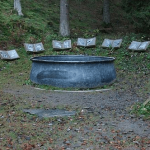 History
History  History
History  Technology
Technology Top 10 Everyday Tech Buzzwords That Hide a Darker Past
 Humans
Humans 10 Everyday Human Behaviors That Are Actually Survival Instincts
 Animals
Animals 10 Animals That Humiliated and Harmed Historical Leaders
 History
History 10 Most Influential Protests in Modern History
 Creepy
Creepy 10 More Representations of Death from Myth, Legend, and Folktale
 Technology
Technology 10 Scientific Breakthroughs of 2025 That’ll Change Everything
 Our World
Our World 10 Ways Icelandic Culture Makes Other Countries Look Boring
 Misconceptions
Misconceptions 10 Common Misconceptions About the Victorian Era
 Mysteries
Mysteries 10 Strange Unexplained Mysteries of 2025
 History
History 10 Things You Didn’t Know About the American National Anthem
 Technology
Technology Top 10 Everyday Tech Buzzwords That Hide a Darker Past
 Humans
Humans 10 Everyday Human Behaviors That Are Actually Survival Instincts
Who's Behind Listverse?

Jamie Frater
Head Editor
Jamie founded Listverse due to an insatiable desire to share fascinating, obscure, and bizarre facts. He has been a guest speaker on numerous national radio and television stations and is a five time published author.
More About Us Animals
Animals 10 Animals That Humiliated and Harmed Historical Leaders
 History
History 10 Most Influential Protests in Modern History
 Creepy
Creepy 10 More Representations of Death from Myth, Legend, and Folktale
 Technology
Technology 10 Scientific Breakthroughs of 2025 That’ll Change Everything
 Our World
Our World 10 Ways Icelandic Culture Makes Other Countries Look Boring
 Misconceptions
Misconceptions 10 Common Misconceptions About the Victorian Era
 Mysteries
Mysteries 10 Strange Unexplained Mysteries of 2025
10 Historical Sites Every Traveler Should Visit
Ready to follow in the footsteps of history? This tour of ten must-visit historical sites will excite your inner history buff. From ancient wonders to modern marvels, these spots are the real deal.
Related: Top 10 UK Locations from Literary Works That You Can Actually Visit
10 Colosseum
Four million visitors marvel at the Colosseum’s structure and rich history every year. Built in Rome, Italy, this iconic amphitheater is a must-see for any traveler who appreciates ancient architecture and culture.
Constructed from AD 72 to AD 80 under the direction of Emperor Vespasian, the Colosseum was used to host public events. Initially, it hosted gladiator battles, animal hunts, and reenactments of famous battles. It could even house up to 80,000 spectators.
The Colosseum is a triumph of ancient engineering. Its elliptical shape and towering arches showcase the ingenuity of Roman architecture. Constructed using travertine limestone and concrete, it remains an unparalleled masterpiece of craftsmanship.
Despite various modifications, earthquakes, and looting, the Colosseum stands intact. Guided tours now allow visitors to explore the arena’s underground chambers and climb the upper levels for panoramic views of Rome.
9 Petra
Petra is an inspiring archaeological site in the desert canyons of Jordan. The city, crafted by the Nabatean civilization, is carved into red sandstone cliffs. And it is often referred to as the “Rose City” due to the rosy coloring of its rock-cut buildings.
From 300 BC, Petra was the capital of the Nabatean Kingdom. It was considered a hub for trade routes linking the Arabian Peninsula, Egypt, and Syria. The location made it a center of commerce, with camel caravans loaded with spices, silks, and incense passing through its gates.
The most iconic feature of Petra is the Treasury, or Al-Khazneh, a facade carved into the cliff face. Archeologists believe it must have been a royal tomb. As sunlight filters through the narrow canyon known as the Siq, the Treasury emerges like a mirage, its details illuminated in hues of pink and gold. It even served as a backdrop for movies like Indiana Jones and the Last Crusade.
But Petra is much more than just the Treasury. The ancient city sprawls over a wide area, boasting tombs, temples, theaters, and a sophisticated water management system. The Monastery is another impressive monument. It stands atop a mountain reached only by a challenging hike, rewarding adventurers with views of the surrounding desert.
Today, Petra is a UNESCO World Heritage Site and a symbol of Jordan’s rich cultural heritage. Visitors wander through its ancient streets, immersing themselves in the beauty of this desert jewel.
8 Ellis Island
Ellis Island, the gateway to the American Dream, symbolizes hope, perseverance, and the immigrant experience. This tiny patch of land in the New York Harbor attracts over four million visitors. People flock there, seeking to connect with their ancestors or understand the hardships and successes of those who came before them.
From 1892 to 1954, Ellis Island served as the nation’s busiest immigrant inspection station, welcoming over 12 million immigrants seeking a new life in the United States. As ships approached its shores, hopeful faces peered out, eager to glimpse the land of opportunity. For many, Ellis Island was their first taste of America—a place where dreams were forged (and often dashed).
Walking through the halls of the Ellis Island National Museum of Immigration, visitors can trace the footsteps of those who embarked on the journey to a new homeland. With its ample space and vaulted ceiling, the Great Hall once echoed with the chatter of countless languages. Crowds of immigrants underwent medical examinations and legal inspections.
Today, Ellis Island is a memorial to those who passed through its gates, a reminder of the richness and complexity of the American identity. Its restored buildings and exhibits offer a glimpse into the past, allowing visitors to reflect on the sacrifices and contributions of immigrants in shaping American society.
7 Machu Picchu
Among Peru’s green peaks of the Andes Mountains lies the ancient Incan citadel of Machu Picchu. Dubbed one of the New Seven Wonders of the World, Machu Picchu is a bucket-list destination for travelers seeking a glimpse into the mystical past of the Inca civilization.
Eight thousand feet above sea level, Machu Picchu offers visitors panoramic views of the surrounding cloud forests and valleys. Built during the 15th century and abandoned just a century later, this site remained hidden from the outside world until its rediscovery by American explorer Hiram Bingham in 1911.
The architecture of Machu Picchu includes precise stone constructions, including temples, terraces, and residential buildings. It showcases advanced engineering techniques that have withstood the test of time and seismic activity.
Today, Machu Picchu draws 1.5 million visitors yearly, eager to explore its ancient mysteries and marvel at its stunning beauty. Whether hiking the famed Inca Trail or taking the scenic train ride from Cusco, experiencing Machu Picchu is a journey back in time.
6 Stonehenge
Stonehenge, the circle of standing stones in the English countryside, is a must-see for any traveler. Situated on Salisbury Plain in Wiltshire, England, this site has captivated visitors for centuries with its timeless allure.
Stonehenge, dating to around 3,000 BC, is steeped in history and speculation. While its purpose remains a mystery, archaeologists believe it served as a ceremonial site, possibly for rituals, burial grounds, or astronomical observations. The arrangement of the stones, some weighing up to 25 tons, continues to baffle experts and ignite the imaginations of all who see them.
One of Stonehenge’s most interesting features is its alignment with the solstices. During the summer and winter solstices, the rising and setting sun aligns with the stones, suggesting an understanding of celestial movements by its ancient builders.
Visitors to Stonehenge can explore the site’s visitor center, which offers exhibits detailing the monument’s history and significance. Guided tours provide insight into the theories surrounding Stonehenge’s construction and purpose, adding intrigue to the visitor experience.
5 The Forbidden City
In Beijing, China, the Forbidden City is a tribute to the country’s rich imperial history. Spanning 180 acres and over 980 buildings, it’s a colossal complex that once served as the imperial palace for 24 emperors during the Ming and Qing dynasties.
Constructed between 1406 and 1420, this UNESCO World Heritage Site is a masterpiece of traditional Chinese architecture, featuring intricate designs, vibrant colors, and majestic palaces. Its name, “Forbidden City,” originates from the fact that access to the palace was limited to the emperor, his family, and his closest advisors. Commoners were forbidden from entering without special permission. This added an air of mystery and exclusivity.
Walking through the courtyards and halls of the Forbidden City, visitors are transported to the height of imperial China. Each building tells a story of power, politics, and tradition, offering a glimpse into the opulent lifestyle of China’s emperors. Highlights include the Hall of Supreme Harmony, where grand ceremonies and imperial banquets took place, and the Palace of Heavenly Purity, which served as the living quarters for emperors and their families.
The Forbidden City also houses a collection of art and artifacts, including ancient ceramics, paintings, and imperial treasures. It’s a trove of Chinese culture and history, offering visitors a chance to dive into the country’s past. Today, the Forbidden City remains one of China’s most visited tourist attractions, drawing over 16 million visitors annually.
4 Great Wall of China
Stretching across the northern part of China like a dragon’s spine, the Great Wall is a wonder of engineering and human perseverance. It is one of the most impressive architectural feats in history, measuring approximately 13,170 miles (21,196 kilometers). So it’s no surprise that it took several centuries to construct.
Originally, the wall was constructed to protect China from invading tribes, notably the Mongols. The earliest sections of the wall date back to the 7th century BC. However, most of what remains today was built during the Ming Dynasty (1368–1644 AD). Despite being called a single structure, the wall is actually a series of fortifications, including walls, watchtowers, and fortresses strategically built along the northern borders of China.
Walking along the Great Wall, you’ll be struck by its sheer scale. The wall winds through rugged mountains, vast deserts, and lush plains, offering vistas at every turn. While some sections have been beautifully restored and are easily accessible to visitors, others remain in decay, adding to the wall’s appeal.
One of the most popular sections is Badaling, located just north of Beijing. For a more adventurous experience, consider hiking along the wild and remote sections of the wall, such as Jiankou or Jinshanling, where you can admire the untouched beauty of this ancient marvel.
3 The Pyramids at Giza
Welcome to one of the world’s most iconic wonders, the Pyramids at Giza. Situated on the outskirts of Cairo, Egypt, these structures have intrigued travelers and historians for centuries.
Built over 4,500 years ago during the Old Kingdom period of ancient Egypt, the Pyramids were constructed as tombs for the pharaohs Khufu, Khafre, and Menkaure. The Great Pyramid of Giza, also known as the Pyramid of Khufu, is the largest of the three, standing at approximately 455 feet (138 meters). It held the title of the tallest man-made structure for over 3,800 years.
Moreover, the precision and engineering prowess displayed in their construction continues to baffle experts. Each stone block, weighing several tons, was meticulously quarried, transported, and assembled with astonishing accuracy. This showcased the advanced architectural skills of the ancient Egyptians.
Aside from their architectural wonder, the Pyramids hold cultural and historical significance. They serve as a witness to the power of ancient Egypt, offering a view into the beliefs and practices of one of the world’s oldest cultures.
2 Sukhothai
In Thailand lies the ancient city of Sukhothai, a UNESCO World Heritage Site that’s a must-visit for history buffs and culture enthusiasts alike. Dating back to the 13th century, Sukhothai served as the capital of the Sukhothai Kingdom, often considered the cradle of Thai civilization.
Wandering through Sukhothai Historical Park, visitors are transported back in time amidst the ruins of temples, palaces, and statues. Each landmark whispers tales of a bygone era. The park spans over 70 square kilometers and showcases the period’s architectural brilliance and artistic mastery.
Beyond its architecture, Sukhothai is steeped in rich history. Here, King Ramkhamhaeng, the monarch credited with inventing the Thai alphabet, ruled during a golden age of prosperity and cultural advancement. His legacy lives on in the inscriptions found on stone tablets scattered throughout the park, providing insight into daily life and governance in ancient Thailand.
From exploring the ruins by bicycle or simply soaking in the tranquil atmosphere, Sukhothai delights visitors with its timeless beauty and historical significance.
1 Easter Island
Easter Island is a gem in the vastness of the Pacific Ocean. This remote island, located 2,300 miles (3,700 kilometers) off the coast of Chile, is famous for its stone statues called Moai.
Between the 13th and 16th centuries, the Rapa Nui people crafted massive statues, some of which tower up to 33 feet (10 meters) tall and weigh over 80 tons. The mystery surrounding how these ancient people managed to carve and transport these behemoths across the island continues to fascinate visitors.
Aside from the iconic Moai, Easter Island boasts stunning landscapes. From rugged coastlines to volcanic craters, it’s truly a paradise for adventurous souls. The island’s unique blend of Polynesian and South American cultures is reflected in its art, music, and traditional dance performances, providing visitors with a rich cultural experience.
Additionally, the island offers hiking, snorkeling, and diving opportunities for nature enthusiasts, allowing you to explore its diverse marine life and lush landscapes. No trip to Easter Island would be complete without witnessing the breathtaking sunrise or sunset behind the Moai statues. It casts an ethereal glow over these silent sentinels of the past.








